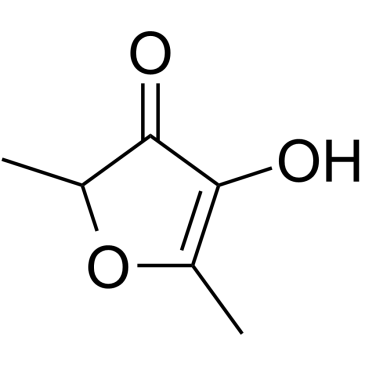4-Hydroxy-2,5-dimethylfuran-3(2H)-one

4-Hydroxy-2,5-dimethylfuran-3(2H)-one structure
|
Common Name | 4-Hydroxy-2,5-dimethylfuran-3(2H)-one | ||
|---|---|---|---|---|
| CAS Number | 3658-77-3 | Molecular Weight | 128.126 | |
| Density | 1.3±0.1 g/cm3 | Boiling Point | 215.5±40.0 °C at 760 mmHg | |
| Molecular Formula | C6H8O3 | Melting Point | 73-77 °C(lit.) | |
| MSDS | Chinese USA | Flash Point | 90.5±20.8 °C | |
| Symbol |

GHS07 |
Signal Word | Warning | |
|
Odorants in breast milk.
Arch. Pediatr. Adolesc. Med. 157(10) , 1031, (2003)
|
|
|
Structural basis for the enzymatic formation of the key strawberry flavor compound 4-hydroxy-2,5-dimethyl-3(2H)-furanone.
J. Biol. Chem. 288(23) , 16815-26, (2013) The last step in the biosynthetic route to the key strawberry flavor compound 4-hydroxy-2,5-dimethyl-3(2H)-furanone (HDMF) is catalyzed by Fragaria x ananassa enone oxidoreductase (FaEO), earlier putatively assigned as quinone oxidoreductase (FaQR). The ripen... |
|
|
Characterization of the key aroma compounds in soy sauce using approaches of molecular sensory science.
J. Agric. Food Chem. 55(15) , 6262-9, (2007) Application of aroma extract dilution analysis (AEDA) to the volatiles isolated from a commercial Japanese soy sauce revealed 30 odor-active compounds in the flavor dilution (FD) factor range of 8-4096, among which 2-phenylethanol showed the highest FD factor... |
|
|
Effects of water-soluble natural antioxidants on photosensitized oxidation of conjugated linoleic acid in an oil-in-water emulsion system.
J. Food Sci. 73(4) , C256-61, (2008) The effect of photosensitized oxidation of conjugated linoleic acid in an oil-in-water (o/w) emulsion system was studied. Water-soluble natural antioxidants, including apple polyphenols from apple extract, green tea extract, 4-hydroxy-2(or 5)-ethyl-5(or2)-met... |
|
|
Quantification of 2,5-dimethyl-4-hydroxy-3(2H)-furanone using solid-phase extraction and direct microvial insert thermal desorption gas chromatography-mass spectrometry.
J. Chromatogr. A. 1208(1-2) , 197-201, (2008) A GC-MS method for the determination of furaneol in fruit juice was developed using Lichrolut-EN solid-phase extraction (SPE) coupled to microvial insert thermal desorption. Lichrolut-EN can effectively extract furaneol from juice, and had much less retention... |
|
|
Determination of furaneol (4-hydroxy-2,5-dimethyl-3(2H)-furanone) in some wines from Italian native grapes by Gas-Chromatography-SIM/MASS spectrometry.
Ann. Chim. 95(6) , 415-9, (2005) Gas Chromatography-Mass Spectrometry (GC-MS) analysis by Selective Ion Monitoring (SIM) was applied to quantify 4-Hydroxy-2,5-dimethyl-3(2H)-furanone (HDMF) in both red and white wines obtained from some Italian cultivar of Vitis vinifera. Wines were extracte... |
|
|
Mechanisms of melanogenesis inhibition by 2,5-dimethyl-4-hydroxy-3(2H)-furanone.
Br. J. Dermatol. 157(2) , 242-8, (2007) Increased production and accumulation of melanin is characteristic of a large number of skin diseases, including acquired hyperpigmentation such as melasma, postinflammatory melanoderma and solar lentigo. Thus, there is a increasing need for the development o... |
|
|
Up- and down-regulation of Fragaria x ananassa O-methyltransferase: impacts on furanone and phenylpropanoid metabolism.
J. Exp. Bot. 57(10) , 2445-53, (2006) A complex mixture of hundreds of substances determines strawberry (Fragaria x ananassa) aroma, but only approximately 15 volatiles are considered as key flavour compounds. Of these, 4-hydroxy-2,5-dimethyl-3(2H)-furanone (HDMF) is regarded as the most importan... |
|
|
Absorption of 3(2H)-furanones by human intestinal epithelial Caco-2 cells.
J. Agric. Food Chem. 57(9) , 3949-54, (2009) A number of 3(2H)-furanones are synthesized by fruits and have been found in cooked foodstuffs, where they impart flavor and odor because of their low perception thresholds. They show genotoxic properties in model studies but are also ranked among the antioxi... |
|
|
Generation of 4-hydroxy-2,5-dimethyl-3(2H)-furanone from rhamnose as affected by reaction parameters: experimental design approach.
J. Agric. Food Chem. 57(7) , 2889-95, (2009) The formation of 4-hydroxy-2,5-dimethyl-3(2H)-furanone (HDMF) was studied in aqueous model systems containing L-rhamnose and L-lysine. The approach consisted in systematically varying four reaction parameters (rhamnose concentration, rhamnose to lysine ratio,... |